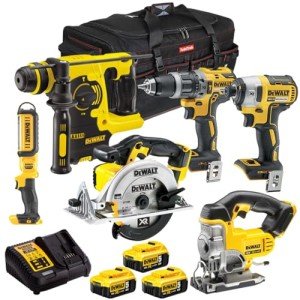
Power Tool Combo
Add a review FollowOverview
-
Founded Date 2017 年 9 月 28 日
-
Sectors Transportation
-
Posted Jobs 0
-
Viewed 14
Company Description
10 Things That Your Family Taught You About Battery Powered Tool Set
Comprehensive Guide to Battery-Powered Tool Sets
Recently, battery-powered tools have actually transformed the way both experts and DIY lovers approach their projects. With their convenience and efficiency, battery-powered tool sets have become a staple in workshops across the country. This post looks into the advantages of Battery Powered Tool Set-powered tools, necessary parts, comparisons, and answers to some frequently asked concerns.
Why Choose Battery-Powered Tool Sets?
Battery-powered tools provide various advantages over their corded equivalents:

-
Portability: Without the limitation of a cable, battery-powered tools can be easily transported and utilized anywhere.
-
Convenience: Quick setups remove the need for outlet access, making them ideal for outside projects.
-
Lowered Trip Hazards: The lack of cords permits a more secure workspace, especially in congested or messy environments.
-
Technological Advancements: Most modern battery-powered tools feature effective lithium-ion batteries that offer longer runtimes and faster charging times.
Key Components of a Battery-Powered Tool Set
A typical battery-powered Cordless Power Tool Kits set may consist of different tools tailored to meet the requirements of different tasks. Below is a detailed table showcasing standard tools discovered in these sets:
| Tool | Purpose | Typical Battery Voltage | Common Brands |
|---|---|---|---|
| Drill/Driver | For drilling holes and driving screws | 12V to 20V | DEWALT, Makita, Milwaukee |
| Circular Saw | For cutting wood, plywood, and other materials | 18V to 20V | Bosch, Ryobi, Black+Decker |
| Reciprocating Saw | For demolition and rough cuts in different materials | 18V | Porter-Cable, Hitachi |
| Impact Driver | For driving large screws/fasteners | 12V to 20V | Craftsman, Ridgid |
| Sander | For smoothing surface areas and ending up wood | 12V to 20V | Ryobi, Milwaukee |
| Angle Grinder | For cutting and grinding metal, masonry, and tiles | 18V | Makita, DEWALT |
| Jigsaw | For complex cuts in wood, plastic, and metal | 12V to 20V | Black+Decker, Bosch |
Significant Features to Consider
When picking a battery-powered tool set, a number of features can enhance usability and performance:
-
Battery Life: Look for tools with lithium-ion batteries that provide longer runtimes and charge quickly.
-
Interchangeability: Some tool sets permit battery compatibility throughout multiple tools, decreasing the requirement for multiple batteries.
-
Weight: Consider the ergonomics; lighter tools can minimize fatigue throughout comprehensive usage.
-
Toughness: Robust construction and protective features (like dust and water resistance) make sure the durability of the tools.
-
Guarantee and Support: Good brand names normally use guarantees that cover flaws and offer consumer support for inquiries.
Comparing Battery-Powered Tools to Corded Tools
The option between battery-powered and corded tools typically boils down to individual preference and task requirements. Here’s a contrast:
| Feature | Battery-Powered Tools | Corded Tools |
|---|---|---|
| Portability | High – can be utilized anywhere | Limited – needs distance to Power Tools Kit outlets |
| Runtime | Restricted by battery life | Continuous as long as plugged in |
| Cheap Power Tool Sets Output | Generally less powerful than corded | Frequently more powerful |
| Maintenance | Needs battery care | Lower maintenance; more straightforward |
| Price | Typically higher preliminary investment | More cost-efficient for individual tools |
| Versatility | Lots of multi-purpose tools offered | Specialized tools available |
Best Practices for Using Battery-Powered Tool Sets
To make the most out of a battery-powered tool set, follow these best practices:
-
Charge Batteries Regularly: To make sure optimum battery life, avoid deep discharging and charge batteries after each use.
-
Clean Tools After Use: Keeping your tools tidy reduces wear and tear and can help maintain their life expectancy.
-
Shop Safely: Keep tools in a dry, safe place to prevent damage and ensure simple access.
-
Read User Manuals: Each tool might have specific operating guidelines or maintenance suggestions; checking out the handbook can conserve time and aggravation.
Regularly Asked Questions (FAQs)
1. How long do battery-powered tools last?
The lifespan of battery-powered tools depends upon usage and upkeep however can last several years with appropriate care. Lithium-ion batteries typically last 2-3 years, depending on charging practices.
2. Can I utilize my battery-powered tools in cold weather?
Extreme cold can impact battery performance. It’s best to keep batteries at room temperature level when not in use and allow them to warm up before usage in cold conditions.
3. Are all battery-powered tools suitable with the very same battery?
Not always. Battery compatibility often depends on the brand name and particular tool design. It’s essential to verify compatibility before buying additional tools.
4. How do I keep lithium-ion batteries?
To maintain lithium-ion batteries, avoid total discharges, keep them cool, and charge them after use. It’s also recommended to utilize the maker’s battery charger.
5. What are the most vital tools for a newbie?
For newbies, a drill/driver, circular saw, and impact motorist are frequently the most essential tools to start with, as they cover a large range of basic projects.
Battery-powered tool sets have transformed how we approach standard jobs, supplying a mix of convenience and performance. Whether for expert trades or DIY home enhancements, these tools deal with varied project requirements. By comprehending the features, parts, and best practices connected with battery-powered tools, users can enhance their effectiveness and performance. Armed with this thorough guide, both novices and skilled professionals can now make informed choices when picking their next tool set.


